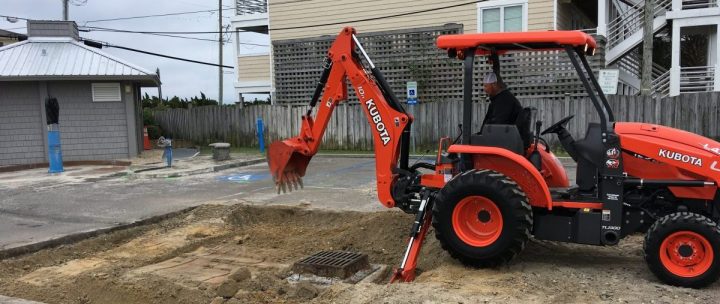
WRIGHTSVILLE BEACH – To passersby, it might look like a few simple squares of pavement, but the new and improved cutouts at one town parking lot are reducing stormwater runoff and improving local water quality.
This project that started in November is the latest effort by the North Carolina Coastal Federation, along with the town of Wrightsville Beach and the Hanover Seaside Club, to remove pollutants that would otherwise flow directly into Banks Channel, a popular and heavily used recreation spot.
Supporter Spotlight
The work at a town’s public parking lot adjacent to Oceanic Restaurant was the first of a two-phase project funded by a grant from the Clean Water Management Trust Fund to redirect runoff from existing street and parking lot pavement and drains. The second phase is scheduled this winter at the Hanover Seaside Club, just a fraction of a mile away.

“This area is heavily used for swimming, boating, surfing, fishing,” said Tracy Skrabal, coastal scientist and southeast regional manager for the federation. “And it’s also heavily used for traffic and business. Bacteria and sediments are being dumped into the very waters we play in. There’s an economic value to disconnect that process.”
For many of these water-quality projects, the goal is to showcase innovative approaches to educate and encourage these municipalities and agencies, such as the North Carolina Department of Transportation, to design their projects from the outset in a way that saves money and better protects our waters.
“In this particular case, we can demonstrate that there are cost-effective ways to do this,” Skrabal said. Not every project is a new one, but communities and developments can also consider retrofitting paved areas in a way that is both practical and efficient.
During the first phase, workers cut out sections of the existing pavement around the drains and installed pervious pavement around them. Engineers can calculate the runoff that happens in a particular parking area during a typical storm, she said. Using these calculations, they can determine exactly how large a pervious section needs to be to so the water can be filtered before it reaches the waterways.
Supporter Spotlight
“Because parking lots are graded, the water flows into these sections,” Skrabal said. “One hundred percent of the rainfall can hit these pervious areas. That stormwater is carrying all the bad stuff that would be large enough to reach the drain and go into the channel.”
The project also includes monitoring, to make sure the outcome is as expected. So far, evidence says these pervious pavement efforts work, said Mike Mallin, a researcher professor at the Center for Marine Science at the University of North Carolina Wilmington. The Aquatic Ecology Laboratory there assesses the components of marine, estuarine and freshwater ecosystems and studies water quality. First, they measure what and how much sediment and bacteria drain into waterways from certain locations, he said, and then return to see if the measures are making a difference.

“When it rains, an excess load of fecal microbes enters the water,” Mallin said. “We have to close waters for swimming alerts. It’s bad for the public and the public perception of our waterways.”
Using these sections of pervious pavement can divert the water into the ground, rather than the drain.
“Wrightsville is a barrier island, and we can use the sand in a positive way,” Mallin said. “This directs runoff from parking lots and roadways to settle down into the soil. It’s highly effective.”
Timothy Owens, town manager for Wrightsville Beach, said that it is always bad news when an area must be closed for swimming and recreation because of runoff. He has seen the benefits of partnering with the federation on such projects.
“We talked about some of the worst offenders in those terms,” Owens said. “They’ve been good neighbors for us in helping us achieve better water quality. I think these are good project for any community to do.”

This is the third large-scale project in a series designed to improve the water quality around Wrightsville Beach. Earlier this year, an infiltration project was installed at the Blockade Runner Beach Resort that redirects much of the polluted runoff from the resort and adjacent roads into the ground through an engineered infiltration system. That project disconnected two stormwater outfall pipes that drained from the 2-acre resort site into Banks Channel.

The stormwater was then redirected into a series of pipes underneath the sound-side lawn of the resort. A 2,100-gallon cistern was also installed to collect rainwater to use for irrigation, reducing the resort’s municipal water use by around 25 percent. There was also a retrofit at a 0.26-acre lot on Lynnwood Drive in the Glen Meade subdivision in Wilmington, which collects about 20 acres of the neighborhood in Hewletts Creek.
Skrabal said she’s appreciative of the Clean Water Management Trust Fund for supporting these efforts to clean up these waterways that are used by so many residents and visitors. This project is part of a $193,000 grant from the fund for a two-phase stormwater project.
“This pervious pavement replacement is Phase 1, which costs approximately $35,000 for design and construction,” she said.
The second, larger phase includes the work at Hanover Seaside Club. The budget also pays for administration and oversight, and for monitoring of the Hanover Seaside Club. The next phase is tentatively planned for February and March, depending on the permitting process.







